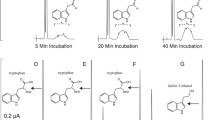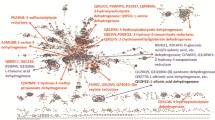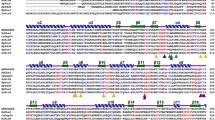Abstract
Plant aminoaldehyde dehydrogenases (AMADHs, EC 1.2.1.19) belong to the family 10 of aldehyde dehydrogenases and participate in the metabolism of compounds related to amino acids such as polyamines or osmoprotectants. Their broad specificity covers ω-aminoaldehydes, aliphatic and aromatic aldehydes as well as nitrogen-containing heterocyclic aldehydes. The substrate preference of plant AMADHs is determined by the presence of aspartic acid and aromatic residues in the substrate channel. In this work, 15 new N-acyl derivates of 3-aminopropanal (APAL) and 4-aminobutanal (ABAL) were synthesized and confirmed as substrates of two pea AMADH isoenzymes (PsAMADH 1 and 2). The compounds were designed considering the previously demonstrated conversion of N-acetyl derivatives as well as substrate channel dimensions (5–8 Å × 14 Å). The acyl chain length and its branching were found less significant for substrate properties than the length of the initial natural substrate. In general, APAL derivatives were found more efficient than the corresponding ABAL derivatives because of the prevailing higher conversion rates and lower K m values. Differences in enzymatic performance between the two isoenzymes corresponded in part to their preferences to APAL to ABAL. The higher PsAMADH2 affinity to substrates correlated with more frequent occurrence of an excess substrate inhibition. Molecular docking indicated the possible auxiliary role of Tyr163, Ser295 and Gln451 in binding of the new substrates. The only derivative carrying a free carboxyl group (N-adipoyl APAL) was surprisingly better substrate than ABAL in PsAMADH2 reaction indicating that also negatively charged aldehydes might be good substrates for ALDH10 family.






Similar content being viewed by others
Abbreviations
- Ac-ABAL:
-
4-Acetamidobutanal
- Ac-APAL:
-
3-Acetamidopropanal
- ALDH:
-
Aldehyde dehydrogenase
- AMADH:
-
Aminoaldehyde dehydrogenase
- APAL:
-
3-Aminopropanal
- ABAL:
-
4-Aminobutanal
- BAL:
-
Betaine aldehyde
- BADH:
-
Betaine aldehyde dehydrogenase
- GABA:
-
4-Aminobutyric acid
- GBAL:
-
4-Guanidinobutanal
- PsAMADH:
-
Aminoaldehyde dehydrogenase from pea (Pisum sativum)
- TMABAL:
-
4-Trimethylaminobutanal
References
Ando T, Yamawaki J (1979) Pottasium fluoride on celite. A versatile reagent for C-, N-, O- and S-alkylations. Chem Lett 1:45–46. doi:10.1246/cl.1979.45
Awal HMA, Yoshida I, Doe M, Hirasawa E (1995) 3-aminopropionaldehyde dehydrogenase of millet shoots. Phytochemistry 40:393–395. doi:10.1016/0031-9422(95)00293-G
Bradbury LMT, Gillies SA, Brushett DJ, Waters DLE, Henry RJ (2008) Inactivation of an aminoaldehyde dehydrogenase is responsible for fragnance in rice. Plant Mol Biol 68:439–449. doi:10.1007/s11103-008-9381-x
Brocker C, Vasiliou M, Carpenter S, Carpenter C, Zhang Y, Wang X, Kotchoni SO, Wood AJ, Kirch HH, Kopečný D, Nebert DW, Vasiliou V (2013) Aldehyde dehydrogenase (ALDH) superfamily in plants: gene nomenclature and comparative genomics. Planta 237:189–210. doi:10.1007/s00425-012-1749-0
Case DA, Cheatham III TE, Darden T, Gohlke H, Luo R, Merz Jr. KM, Onufriev A, Simmerling C, Wang B, Woods RJ (2005) The amber biomolecular simulation programs. J Comput Chem 26:1668–1688. doi:10.1002/jcc.20290
Chakraborty M, Karun A, Mitra A (2009) Accumulation of phenylpropanoid derivatives in chitosan-induced cell suspension culture of Cocos nucifera. J Plant Phys 166:63–71. doi:10.1016/j.jplph.2008.02.004
Díaz-Sánchez AG, González-Segura L, Mújica-Jiménez C, Rudiño-Piñera E, Montiel C, Martínez-Castilla LP, Muñoz-Clares RA (2012) Amino acid residues critical for the specificity for betaine aldehyde of the plant ALDH10 isoenzyme involved in the synthesis of glycine betaine. Plant Physiol 158:1570–1582. doi:10.1104/pp.112.194514
Frisch MJ, Trucks GW, Schlegel HB, Scuseria GE, Robb MA, Cheeseman JR, Montgomery JA Jr, Vreven T, Kudin KN, Burant JC, Millam JM, Iyengar SS, Tomasi J, Barone V, Mennucci B, Cossi M, Scalmani G, Rega N, Petersson GA, Nakatsuji H, Hada M, Ehara M, Toyota K, Fukuda R, Hasegawa J, Ishida M, Nakajima T, Honda Y, Kitao O, Nakai H, Klene M, Li X, Knox JE, Hratchian HP, Cross JB, Bakken V, Adamo C, Jaramillo J, Gomperts R, Stratmann RE, Yazyev O, Austin AJ, Cammi R, Pomelli C, Ochterski JW, Ayala PY, Morokuma K, Voth GA, Salvador P, Dannenberg JJ, Zakrzewski VG, Dapprich S, Daniels AD, Strain MC, Farkas O, Malick DK, Rabuck AD, Raghavachari K, Foresman JB, Ortiz JV, Cui Q, Baboul AG, Clifford S, Cioslowski J, Stefanov BB, Liu G, Liashenko A, Piskorz P, Komaromi I, Martin RL, Fox DJ, Keith T, Al-Laham MA, Peng CY, Nanayakkara A, Challacombe M, Gill PMW, Johnson B, Chen W, Wong MW, Gonzalez C, Pople JA (2004) Gaussian 03, Revision C.02. Gaussian Inc, Wallingford
Frömmel J, Soural M, Tylichová M, Kopečný D, Demo G, Wimmerová M, Šebela M (2012) Plant aminoaldehyde dehydrogenase oxidize a wide range of nitrogenous heterocyclic aldehydes. Amino Acids 43:1189–1202. doi:10.1007/s00726-011-1174-x
Fujiwara T, Hori K, Ozaki K, Yokota Y, Mitsuya S, Ichiyanagi T, Hattori T, Takabe T (2008) Enzymatic characterization of peroxisomal and cytosolic betaine aldehyde dehydrogenases in barley. Physiol Plant 134:22–30. doi:10.1111/j.1399-3054.2008.01122.x
Gaid MM, Sircar D, Beurle T, Mitra A, Beerhues L (2009) Benzaldehyde dehydrogenase from chitosan-treated Sorbus aucuparia cell cultures. J Plant Phys 166:1343–1349. doi:10.1016/j.jplph.2009.03.003
Hanson AD, Wyse R (1982) Biosynthesis, translocation, and accumulation of betaine in sugar beet and its progenitors in relation to salinity. Plant Physiol 70:1191–1198. doi:10.1104/pp.70.4.1191
Hanson AD, Rathinatasabapathi B, Rivoal J, Burnet M, Dillon MO, Gages DA (1994) Osmoprotective compounds in the Plumbaginaceae: a natural experiment in metabolic engineering of stress tolerance. Proc Natl Acad Sci USA 91:306–310. doi:10.1073/pnas.91.1.306
Kopečný D, Tylichová M, Snégaroff J, Popelková H, Šebela M (2011) Carboxylate and aromatic active-site residues are determinants of high-affinity binding of ω-aminoaldehydes to plant aminoaldehyde dehydrogenases. FEBS J 278:3130–3139. doi:10.1111/j.1742-4658.2011.08239.x
Kopečný D, Končitíková R, Tylichová M, Vigouroux A, Moskalíková H, Soural M, Šebela M, Moréra S (2013) Plant ALDH10 family: identifying critical residues for substrate specificity and trapping a thiohemiacetal intermediate. J Biol Chem 288:9491–9507. doi:10.1074/jbc.M112.443952
Li W, Yuan XM, Ivanova S, Tracey KJ, Eaton JW, Brunk UT (2003) 3-Aminopropanal, formed during cerebral ischaemia, is a potent lysosomotropic neurotoxin. Biochem J 371:429–436. doi:10.1042/BJ20021520
Long MC, Nagegowda D, Kaminaga Y, Ho KK, Kish CM, Schnepp J, Sherman D, Weiner H, Rhodes D, Dudareva N (2009) Involvement of snapdragon benzaldehyde dehydrogenase in benzoic acid biosynthesis. Plant J 59:256–265. doi:10.1111/j.1365-313X.2009.03864.x
Matsuda H, Suzuki Y (1984) γ-Guanidinobutyraldehyde dehydrogenase of Vicia faba leaves. Plant Physiol 76:654–657. doi:10.1104/pp.76.3.654
Morris GM, Goodsell DS, Halliday RS, Huey R, Hart WE, Belew RK, Olson AJ (1998) Automated docking using a Lamarckian genetic algorithm and an empirical binding free energy function. J Comput Chem 19:1639–1662. doi:10.1002/(SICI)1096-987X(19981115)19:14<1639:AID-JCC10>3.0.CO;2-B
Pearlman DA, Case DA, Caldwell JW, Ross WS, Cheatham III TE, DeBolt S, Ferguson D, Seibel G, Kollman P (1995) Amber, a package of computer programs for applying molecular mechanics, normal mode analysis, molecular dynamics and free energy calculations to simulate the structural and energetic properties of molecules. Comput Phys Commun 91:1–41. doi:10.1016/0010-4655(95)00041-D
Peng X, Shindo K, Kanoh K, Inomata Y, Choi SK, Misawa N (2005) Characterization of Sphingomonas aldehyde dehydrogenase catalyzing the conversion of various aromatic aldehydes to their carboxylic acids. Appl Microbiol Biotechnol 69:141–150. doi:10.1007/s00253-005-1962-x
Prokop M, Adam J, Kříž Z, Wimmerová M, Koča J (2008) TRITON: a graphical tool for ligand-binding protein engineering. Bioinformatics 24:1955–1956. doi:10.1093/bioinformatics/btn344
Rhodes R, Rich PJ, Brunk DG, Ju GC, Rhodes JC, Pauly MH, Hansen LA (1989) Development of two isogenic sweet corn hybrids differing for glycinebetaine content. Plant Physiol 91:1112–1121. doi:10.1104/pp.91.3.1112
Rippa S, Zhao Y, Merlier F, Charrier A, Perrin Y (2012) The carnitine biosynthetic pathway in Arabidopsis thaliana shares similar features with the pathway of mammals and fungi. Plant Physiol Biochem 60:109–114. doi:10.1016/j.plaphy.2012.08.001
Schüttelkopf AW, van Aalten DMF (2004) PRODRG: a tool for high-throughput crystallography of protein-ligand complexes. Acta Cryst D60:1355–1363. doi:10.1107/S0907444904011679
Šebela M, Brauner F, Radová A, Jacobsen S, Havliš J, Galuszka P, Peč P (2000) Characterisation of a homogeneous plant aminoaldehyde dehydrogenase. Biochim Biophys Acta 1480:329–341. doi:10.1016/S0167-4838(00)00086-8
Shelp BJ, Bown AW, McLean MD (1999) Metabolism and functions of gamma-aminobutyric acid. Trends Plant Sci 4:446–452. doi:10.1016/S1360-1385(99)01486-7
Shelp BJ, Bozzo GG, Trobacher CP, Zarei A, Deyman KL, Brikis CJ (2012) Hypothesis/review: contribution of putrescine to 4-aminobutyrate (GABA) production in response to abiotic stress. Plant Sci 193:130–135. doi:10.1016/j.plantsci.2012.06.001
Smith PK, Krohn RI, Hermanson GT, Mallia AA, Gartner FH, Provenzano MD, Fujimoto EK, Goeke NM, Olson BJ, Klenk DC (1985) Measurement of protein using bicinchoninic acid. Anal Biochem 150:76–85. doi:10.1016/0003-2697(85)90442-7
Smith TA, Croker SJ, Loeffler RST (1986) Occurrence in higher-plants of 1-(3-aminopropyl)-pyrrolinium and pyrroline: products of polyamine oxidation. Phytochemistry 25:683–689. doi:10.1016/0031-9422(86)88024-4
Stiti N, Adewale IO, Petersen J, Bartels D, Kirch HH (2011) Engineering the nucleotide coenzyme specificity and sulfhydryl redox sensitivity of two stress-responsive aldehyde dehydrogenase isoenzymes of Arabidopsis thaliana. Biochem J 434:459–471. doi:10.1042/BJ20101337
Tavladoraki P, Rossi MN, Saccuti G, Perez-Amador MA, Polticelli F, Angelini R, Federico R (2006) Heterologous expression and biochemical characterization of a polyamine oxidase from Arabidopsis involved in polyamine back conversion. Plant Physiol 141:1519–1532. doi:10.1104/pp.106.080911
Trossat C, Rathinasabapathi B, Hanson AD (1997) Transgenically expressed betaine aldehyde dehydrogenase efficiently catalyzes oxidation of dimethylsulfoniopropionaldehyde and omega-aminoaldehydes. Plant Physiol 113:1457–1461. doi:10.1104/pp.113.4.1457
Tylichová M, Briozzo P, Kopečný D, Ferrero J, Moréra S, Joly N, Snégaroff J, Šebela M (2008) Purification, cystalization and preliminary crystalografic study of a recombinant plant aminoaldehyde dehydrogenace from Pisum sativum. Acta Cryst F64:88–90. doi:10.1107/S1744309107068522
Tylichová M, Kopečný D, Moréra S, Briozzo P, Lenobel R, Snégaroff J, Šebela M (2010) Structural and functional characterization of plant aminoaldehyde dehydrogenase from Pisum sativum with a broad specificity for natural and synthetic aminoaldehydes. J Mol Biol 396:870–882. doi:10.1016/j.jmb.2009.12.015
Vaz FM, Wanders RJA (2002) Carnitine biosynthesis in mammals. Biochem J 361:417–429. doi:10.1042/0264-6021:3610417
Weigel P, Weretilnyk EA, Hanson AD (1986) Betaine aldehyde oxidation by spinach chloroplasts. Plant Physiol 82:753–759. doi:10.1104/pp.82.3.753
Wood PL, Khan MA, Moskal JR (2007) The concept of “aldehyde load” in neurodegenerative mechanisms: cytotoxicity of the polyamine degradation products hydrogen peroxide, acrolein, 3-aminopropanal, 3-acetamidopropanal and 4-aminobutanal in a retinal ganglion cell line. Brain Res 1145:150–156. doi:10.1016/j.brainres.2006.10.004
Acknowledgments
This work was supported by Grant No. LO1204 from the Ministry of Education, Youth and Sports of the Czech Republic and Grant No. P501/11/1591 from the Czech Science Foundation. The authors thank for the access to computing and storage facilities owned by parties and projects contributing to the National Grid Infrastructure MetaCentrum provided under the program “Projects of Large Infrastructure for Research, Development, and Innovations” (LM2010005).
Conflict of interest
The authors declare no conflict of interest.
Author information
Authors and Affiliations
Corresponding authors
Additional information
Abbreviations for names of all new synthetic N-acyl-ω-aminoaldehydes (15 compounds) are completely elucidated in the supplementary file 1 (Met stands for methyl, Propi for propionyl, Butyr for butyryl, Valer for valeryl and Adip for adipoyl).
Electronic supplementary material
Below is the link to the electronic supplementary material.
Rights and permissions
About this article
Cite this article
Frömmel, J., Šebela, M., Demo, G. et al. N-acyl-ω-aminoaldehydes are efficient substrates of plant aminoaldehyde dehydrogenases. Amino Acids 47, 175–187 (2015). https://doi.org/10.1007/s00726-014-1853-5
Received:
Accepted:
Published:
Issue Date:
DOI: https://doi.org/10.1007/s00726-014-1853-5




